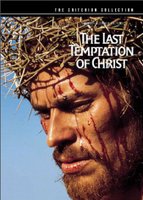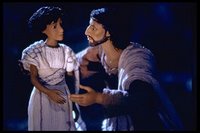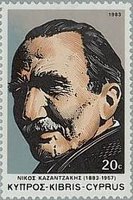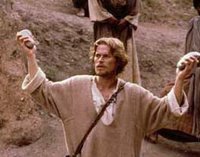 Next weekend I'm due to do a talk on "Blessed are the poor in spirit" which has got me thinking about portrayals of the Sermon on the Mount in film. The different films emphasise different parts of the sermon, although obviously the Beatitudes get a good showing in a lot of different films. Anyway, I thought I'd list some of my favourite portrayals and give a brief explanation.
Next weekend I'm due to do a talk on "Blessed are the poor in spirit" which has got me thinking about portrayals of the Sermon on the Mount in film. The different films emphasise different parts of the sermon, although obviously the Beatitudes get a good showing in a lot of different films. Anyway, I thought I'd list some of my favourite portrayals and give a brief explanation.King of Kings (1961)[Pictured above]
In contrast to Matthew's arrangement, Ray uses the Sermon on the Mount as the climax of the movie's first half. The buzz has been building about Jesus so everyone gathers to hear him preach and check him out. It's a spectacular build up and the idea of Jesus moving through the crowd is good, if lacking in realism. Sadly the post-production overdubbing of Jeffrey Hunter's original vocals leaves this feeling stiff and forced. But the build up and the colours are spectacular.
Gospel According to St. Matthew (1964)
Pasolini's filming of this part of the gospel is perhaps the most interesting, certainly from a scholarly angle. Most scholars believe that rather than their being a single key sermon Matthew 5-7 is a compilation of Jesus' teaching. Some films reflect this by simply splitting up the sermon into different parts and placing them throughout the film. But Pasolini stays true to the gospel by leaving all the material, but also acknowledges the scholarly angle by changing the setting, weather and background Jesus is speaking against as well his clothes and hair. Sadly whilst it's clever, it's also a little dull.
Son of Man (1969)
Dennis Potter's take on the Sermon is to excise the Beatitudes and focus on the "Love your enemy" part of the Sermon. The previous scene is critical here: a group of Roman soldiers have just attacked a local Jewish village and there is a seething contempt in the crowd Jesus addresses. Potter plays fast and loose with the wording, but certainly stays true to the spirit of the text. And Colin Blakely delivery is incredible. One of my favourite clips from a Bible Films ever.
Life of Brian (1979)
Life of Brian's take on the Sermon on the Mount is so well known that I knew all the best jokes before I'd even seen it. Still the timing and delivery are so perfect that even after all the times I've seen it, I'm still amused by "Blessed are the cheesemakers". It was perhaps the first time that anyone had ever considered what it was like to be someone at the edge of one of Jesus' sermons. We often wonder how he would have been able to address such a large crowd, but never consider what it was like for those on the edge. What's also impressive about the scene is how it nails so much of biblical interpretation: "obviously it applies to all makers of dairy produce". Of course if you missed it you may very well not understand the whole film. Not normally a problem unless you're about to be interviewed about it on national television as happened to Malcolm Muggeridge.
Last Temptation of Christ (1988)
Like Potter before him, Paul Schrader plays a little loose with the original wording, and gets brilliant results, again thanks to the lead actor's delivery. Last Temptation opts for Luke's Sermon on the Plain rather than Matthew's Mount, and it fits well with the confrontational prophet that Scorsese portrays in certain parts of the film. The spontaneity of this portrayal has a real vitality about it, and the ending, which makes it a little controversial for church use, nevertheless highlights the issue that occurs again and again in the gospels of Jesus' original audience failing to understand him.
The Miracle Maker (2000)
The Miracle Maker makes little attempt to depict the Sermon on the Mount although it does include a few extracts of some of the less famous passages, at least two of which are animated. The "why, then, do you look at the speck in your brother's eye and pay no attention to the log in your own eye?" is played for great comic effect with the audience laughing in the background. But the best part is Jesus' twin similes contrasting the wise man building his house upon rock with the foolish man building on sand. It's a nicely stylised piece of animation, and rather memorable.
I have a sneaking suspicion that Rossellini's Il Messia also includes a segment of Jesus teaching the disciples the words from the sermon whilst they go about their everyday tasks, but I haven't got the time to check it out just now. Does anyone else have any favourites that I've missed?




































